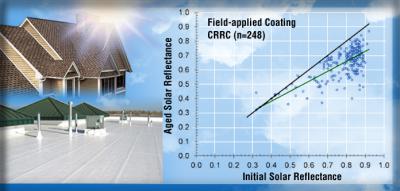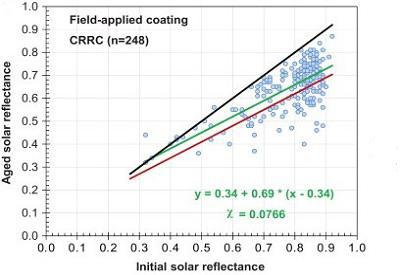Next-Generation Materials
Next-Generation Materials
The goal of our Next-Generation Materials project, sponsored by the U.S. Department of Energy, is to develop and advance to market the next generation of white and colored roofing products with aged solar reflectances superior to those of today's "cool" roofing products.

About
White roofs can keep energy costs down by cooling buildings, mitigate urban heat islands by keeping cities cooler, and counteract climate change by cooling the planet. However, these benefits only apply for as long as the roofs stay clean and white. One challenge therefore facing cool roofs is not only having a high initial level of solar reflectance (SR), but also ensuring adequate aged reflectance. Residential settings, where typically dark shingles are predominant owing to their low cost and aesthetic appeal, present another challenge of optimizing the SR of shingled roofs while offering comparable aesthetics and cost-effectiveness.
The goal of our Next-Generation Materials project, sponsored by the U.S. Department of Energy, is to develop and advance to market the next generation of white and colored roofing products with aged solar reflectances superior to those of today's "cool" roofing products.
For low-slope roofs we are collaborating with Dow Chemical Company to develop white roofs that maintain high solar reflectance after aging (weathering and soiling). This research, in concert with our ongoing efforts to develop accelerated soiling protocols ("Advanced Surfaces" project), will facilitate the development of the next generation of envelope surface materials with improved anti-soiling properties.
For pitched roofs we will focus on the next generation of asphalt shingle roofs. We aim to increase the solar reflectance of factory-produced shingles while maintaining aesthetics and low cost associated with current shingle offerings, in order to reduce the "price premium" over standard shingles. More reflective shingles will also allow buildings to spend less on cooling energy, which will further erode the price premium over time.
For existing shingle roofs that have recently been installed, there is still a way to attain the benefits of a cool roof. We are also working to develop an attractive and cost-effective retrofit coating for shingles that can effectuate the same solar reflectance benefit as new factory-produced shingles.

Contact
Ronnen Levinson
Principal Investigator
(510) 486-7494
George Ban-Weiss
(510) 486-4931